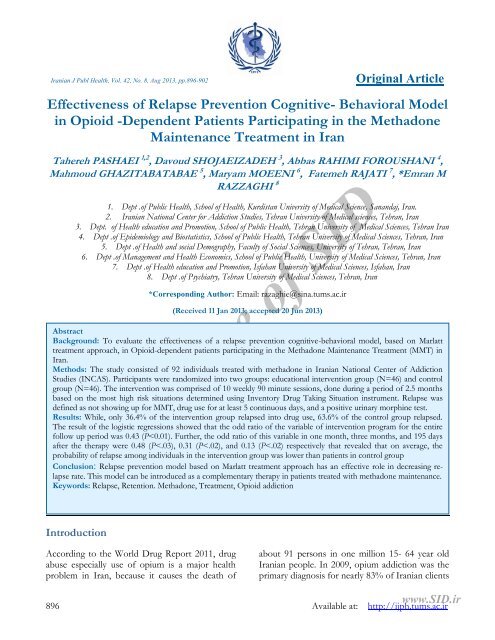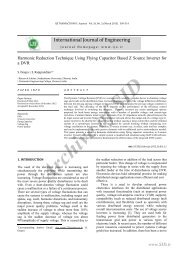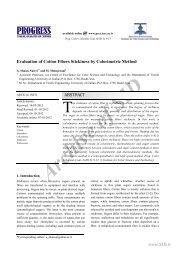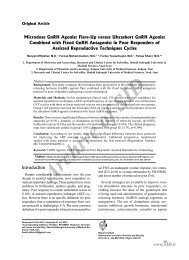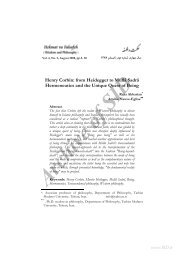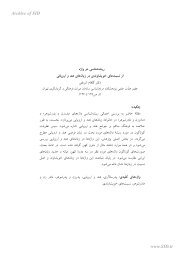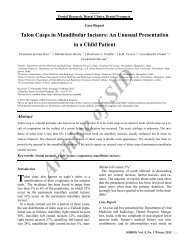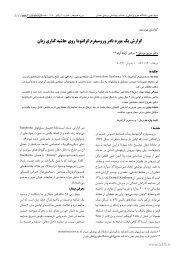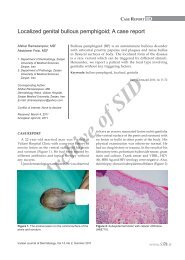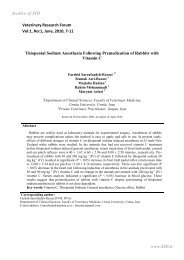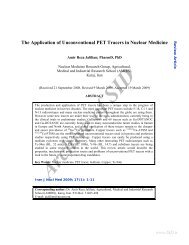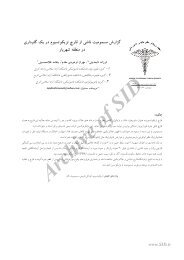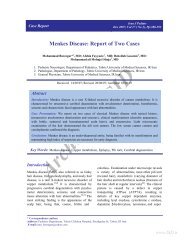effectiveness of relapse prevention cognitive- behavioral model ... - Sid
effectiveness of relapse prevention cognitive- behavioral model ... - Sid
effectiveness of relapse prevention cognitive- behavioral model ... - Sid
You also want an ePaper? Increase the reach of your titles
YUMPU automatically turns print PDFs into web optimized ePapers that Google loves.
Iranian J Publ Health, Vol. 42, No. 8, Aug 2013, pp.896-902<br />
Original Article<br />
Effectiveness <strong>of</strong> Relapse Prevention Cognitive- Behavioral Model<br />
in Opioid -Dependent Patients Participating in the Methadone<br />
Maintenance Treatment in Iran<br />
Tahereh PASHAEI 1,2 , Davoud SHOJAEIZADEH 3 , Abbas RAHIMI FOROUSHANI 4 ,<br />
Mahmoud GHAZITABATABAE 5 , Maryam MOEENI 6 , Fatemeh RAJATI 7 , *Emran M<br />
RAZZAGHI 8<br />
1. Dept .<strong>of</strong> Public Health, School <strong>of</strong> Health, Kurdistan University <strong>of</strong> Medical Science, Sanandaj, Iran.<br />
2. Iranian National Center for Addiction Studies, Tehran University <strong>of</strong> Medical sciences, Tehran, Iran<br />
3. Dept. <strong>of</strong> Health education and Promotion, School <strong>of</strong> Public Health, Tehran University <strong>of</strong> Medical Sciences, Tehran Iran<br />
4. Dept .<strong>of</strong> Epidemiology and Biostatistics, School <strong>of</strong> Public Health, Tehran University <strong>of</strong> Medical Sciences, Tehran, Iran<br />
5. Dept .<strong>of</strong> Health and social Demography, Faculty <strong>of</strong> Social Sciences, University <strong>of</strong> Tehran, Tehran, Iran<br />
6. Dept .<strong>of</strong> Management and Health Economics, School <strong>of</strong> Public Health, University <strong>of</strong> Medical Sciences, Tehran, Iran<br />
7. Dept .<strong>of</strong> Health education and Promotion, Isfahan University <strong>of</strong> Medical Sciences, Isfahan, Iran<br />
8. Dept .<strong>of</strong> Psychiatry, Tehran University <strong>of</strong> Medical Sciences, Tehran, Iran<br />
*Corresponding Author: Email: razaghie@sina.tums.ac.ir<br />
(Received 11 Jan 2013; accepted 20 Jun 2013)<br />
Abstract<br />
Background: To evaluate the <strong>effectiveness</strong> <strong>of</strong> a <strong>relapse</strong> <strong>prevention</strong> <strong>cognitive</strong>-<strong>behavioral</strong> <strong>model</strong>, based on Marlatt<br />
treatment approach, in Opioid-dependent patients participating in the Methadone Maintenance Treatment (MMT) in<br />
Iran.<br />
Methods: The study consisted <strong>of</strong> 92 individuals treated with methadone in Iranian National Center <strong>of</strong> Addiction<br />
Studies (INCAS). Participants were randomized into two groups: educational intervention group (N=46) and control<br />
group (N=46). The intervention was comprised <strong>of</strong> 10 weekly 90 minute sessions, done during a period <strong>of</strong> 2.5 months<br />
based on the most high risk situations determined using Inventory Drug Taking Situation instrument. Relapse was<br />
defined as not showing up for MMT, drug use for at least 5 continuous days, and a positive urinary morphine test.<br />
Results: While, only 36.4% <strong>of</strong> the intervention group <strong>relapse</strong>d into drug use, 63.6% <strong>of</strong> the control group <strong>relapse</strong>d.<br />
The result <strong>of</strong> the logistic regressions showed that the odd ratio <strong>of</strong> the variable <strong>of</strong> intervention program for the entire<br />
follow up period was 0.43 (P
Pashaei et al.: Effectiveness <strong>of</strong> Relapse Prevention Cognitive …<br />
seeking treatment programs (1). Estimates show<br />
that at least 1.2 million people in Iran are dependent<br />
to drug (2). This huge number <strong>of</strong> drug users<br />
apparently should receive appropriate treatment<br />
programs. In terms <strong>of</strong> the public health approach<br />
to the problem, abstinence-oriented treatments<br />
might not work effectively. Thus, harm reduction<br />
with a focus on methadone maintenance treatment<br />
as an effective treatment for opioid would<br />
become a priority (3).<br />
However, retention time in some treatment program<br />
is not favorable (4). In a study, the average<br />
<strong>relapse</strong> rate during six months after treatment admission<br />
in Maragheh (Iran) was 64% indicating<br />
the necessity for developing complementary Relapse<br />
Prevention Treatments (RPT) (5). The <strong>relapse</strong><br />
<strong>prevention</strong> proposed by Marlatt and Gordon based<br />
on <strong>cognitive</strong>-<strong>behavioral</strong> treatment is an influential<br />
treatment programs for drug dependence (6).<br />
In this treatment approach, after identifying high<br />
risk situations leading to drug use and <strong>relapse</strong>, appropriate<br />
interventions are designed and prepared<br />
by therapists. This educational treatment improves<br />
efficacy <strong>of</strong> the MMT program because it provides<br />
patients with an opportunity to develop skills and<br />
strategies that help them coping effectively with<br />
high risk situations related to drug use and realize<br />
and manage <strong>relapse</strong> warning signs (7). The purpose<br />
<strong>of</strong> this paper is to evaluate the <strong>effectiveness</strong><br />
<strong>of</strong> a <strong>relapse</strong> <strong>prevention</strong> <strong>cognitive</strong>-<strong>behavioral</strong> <strong>model</strong>,<br />
based on Marlatt approach in the treatment <strong>of</strong><br />
individuals with opioid use disorder participating<br />
in MMT program at the outpatient clinic <strong>of</strong> the<br />
Iranian National Center for Addiction Studies<br />
(INCAS).<br />
Materials and Methods<br />
Archive <strong>of</strong> SID<br />
This research applied an interventional study design.<br />
As the study was an interventional study, a<br />
sample <strong>of</strong> 92 total patients participating in MMT<br />
program at INCAS was randomly allocated to either<br />
“intervention” or “control” groups. Each<br />
group consisted <strong>of</strong> 46 patients. This study was approved<br />
by the Ethics Committee <strong>of</strong> Tehran University<br />
<strong>of</strong> Medical Sciences. Also, a written consent<br />
was given to all participants prior to participating<br />
in the study.<br />
The inclusion criteria consisted <strong>of</strong> participating on<br />
MMT for at least one month and not suffering<br />
from serious physical or mental illnesses such as<br />
active suicidal or homicidal ideation, frank delusions<br />
or overt aggressive and threatening behaviors.<br />
There was no limitation on gender <strong>of</strong> participants.<br />
However, since most <strong>of</strong> the clients were<br />
male, we recruited only male clients to our study<br />
for the sake <strong>of</strong> statistical purposes. Relapse criteria<br />
were defined as not showing-up for MMT, confirmation<br />
<strong>of</strong> return to drug use for at least five<br />
continuous days and positive urinary morphine<br />
test (random urine testing was a rule at the clinic).<br />
However, there were patients who had discontinued<br />
their program due to other reasons such as<br />
moving to another clinic or program. This latter<br />
group was not counted for <strong>relapse</strong>.<br />
Socio-demographic information, history <strong>of</strong> drug<br />
taking, treatment history, as well as some high risk<br />
behaviors related to addiction were collected<br />
through a short questionnaire. Besides, Farsi version<br />
<strong>of</strong> IDTS was used to identify high risk situations<br />
resulting in drug use and drug <strong>relapse</strong>. The<br />
questionnaire covers 8 types <strong>of</strong> drug taking situations<br />
including unpleasant emotions (ten items),<br />
physical discomfort (five items), pleasant emotions<br />
(five items), testing personal control (five<br />
items), urges and temptations to use (five items),<br />
conflict with others (ten items), social pressure to<br />
use (five items), and pleasant times with others<br />
(five items). Each item consists <strong>of</strong> a four-point<br />
scale. The scoring ranges were from 0 to3, i.e.<br />
never, rarely, frequently, and almost always, respectively<br />
(8). In order to prevent responses under<br />
the influence <strong>of</strong> drugs or drug withdrawal that<br />
could result in suspected unreliability and invalidity,<br />
we applied the one month delay rule for recruiting<br />
on intervention program. Further, r to<br />
evaluate clients’ confidence levels across high risk<br />
situations, the Drug taking Confidence Questionnaire<br />
(DTCQ-8) was utilized (9).<br />
To assess the influence <strong>of</strong> intervention on <strong>relapse</strong><br />
in both the intervention and control group, the<br />
Mantel Haenszel statistical test was used. This test<br />
is used because the effect <strong>of</strong> the intervention variwww.SID.ir<br />
Available at: http://ijph.tums.ac.ir 897
Iranian J Publ Health, Vol. 42, No.8, Aug 2013, pp. 896-902<br />
able on <strong>relapse</strong> is influenced by covariates that can<br />
be controlled. Also, the probability <strong>of</strong> <strong>relapse</strong> in<br />
that regression was <strong>model</strong>ed as a binary response<br />
(1=<strong>relapse</strong>, 0=no <strong>relapse</strong>) in a linear logistic regression<br />
to determine the predictors <strong>of</strong> <strong>relapse</strong>.<br />
The level <strong>of</strong> statistical significance was set at 0.05.<br />
Data analyses were performed using SPSS11.5.<br />
The interventions<br />
This intervention program had a manual suggested<br />
by Alan Marlatt (10-11). It was based on a<br />
logic <strong>model</strong> because we evaluated high risk situations<br />
for each patient. Both one therapist and one<br />
facilitator involved in the intervention were<br />
trained for at least 10 hours. In each session, one<br />
<strong>of</strong> the researchers was used to inspect the therapists’<br />
work according to the group therapy checklist.<br />
The intervention was comprised <strong>of</strong> 10 session <strong>of</strong><br />
group therapy that held weekly. Each session,<br />
which lasted 90 minutes, was dedicated to a specific<br />
topic including introduce intervention and<br />
members <strong>of</strong> group, managing emotions, thought<br />
<strong>of</strong> using substances, craving and urge as well as<br />
social pressure for drug use, <strong>relapse</strong>, anger, in addition<br />
to refusal skills problem solving, communication<br />
skills and building a recovery support system.<br />
Each session was started by reviewing risky situations<br />
patients had faced. The main topic <strong>of</strong> the<br />
session was discussed within a focus group structure.<br />
In addition, at the end <strong>of</strong> each session, patients<br />
were given a reminder sheet that outlined<br />
the elements <strong>of</strong> the session topic and relevant skills.<br />
Also, they did some homework. Compensatory<br />
sessions were planned for participants who had<br />
occasionally missed a particular session. As improvement<br />
<strong>of</strong> self-efficacy is a major component <strong>of</strong><br />
RPT (9), specific attention to this topic was made<br />
in almost every session. Self-presentation <strong>of</strong> success<br />
case stories by clients from outside the group<br />
as social <strong>model</strong>ing was part <strong>of</strong> the practice.<br />
Results<br />
Archive <strong>of</strong> SID<br />
Participants were 37.7(SD=10.9) years old on average<br />
at the time <strong>of</strong> recruitment. The average years<br />
<strong>of</strong> education was 10.14 (SD= 2.8). A proportion<br />
<strong>of</strong> 43.5% <strong>of</strong> the participants was married at the<br />
time <strong>of</strong> recruitment. The unemployment rate<br />
among the study group was 31.5%. About 59% <strong>of</strong><br />
patients had some drug injection experience prior<br />
to recruitment in the treatment program. A total<br />
<strong>of</strong> 63 participants (68.5%) reported poly-drug use.<br />
In addition, 45.7% <strong>of</strong> patients had a history <strong>of</strong><br />
involvement with the law. The mean drug use<br />
span among participants was 14.2 (SD=9.4) years<br />
and the average age <strong>of</strong> starting addiction was<br />
21.86 (SD=7.1) years old.<br />
The result <strong>of</strong> Mantel Henszel test for most <strong>of</strong> the<br />
variables was homogeneous. This means that<br />
there is no difference between those variables for<br />
intervention influence on <strong>relapse</strong> risk probability<br />
(P≥0/05). The effect <strong>of</strong> some variables including<br />
level <strong>of</strong> education, employment status, marital status,<br />
self efficacy, social support, and alcohol were<br />
heterogeneous.<br />
Table 1 shows the results <strong>of</strong> logistic regression<br />
estimation. The odd ratio <strong>of</strong> the variable <strong>of</strong> intervention<br />
program in 30 days, 90 days, and 195 days<br />
after the intervention, (i.e. the follow-up period)<br />
were 0.48, 0.31, and 0.13 respectively. This revealed<br />
that on average, the probability <strong>of</strong> <strong>relapse</strong><br />
among individuals in the intervention group was<br />
lower than patients in control group (Table 1).<br />
Table 1: Result <strong>of</strong> logistic regression for the impact <strong>of</strong><br />
intervention<br />
Response OR P-value 95%CI for OR<br />
Relapse in 30 days 0.48 0.03 0.20-11.46<br />
Relapse in 90 days 0.32 0.02 0.105-0.953<br />
Relapse in 195 0.13 0.02 0.07-0.459<br />
days<br />
Probability <strong>of</strong> <strong>relapse</strong> among illiterate patients,<br />
ones with primary and secondary education, were<br />
respectively about 1.03 and 2.12 times more than<br />
those that had at least a diploma and higher. Relapse<br />
risk for unemployed participants was 3.97<br />
times more than people in full-time jobs. Additionally,<br />
risks <strong>of</strong> <strong>relapse</strong> among participants who<br />
were single and married were about 1.36 and 1.76<br />
times more than divorced and speared ones. Furthermore,<br />
depriving from social support increased<br />
www.SID.ir<br />
898 Available at: http://ijph.tums.ac.ir
Pashaei et al.: Effectiveness <strong>of</strong> Relapse Prevention Cognitive …<br />
risk <strong>of</strong> <strong>relapse</strong> among patient about 1.98 times.<br />
Moreover, risk <strong>of</strong> <strong>relapse</strong> for participants not having<br />
enough self-efficacy as well as those with low<br />
self-efficacy were respectively around 3.93 and<br />
3.05 times more than that <strong>of</strong> enough or high selfefficacy.<br />
Besides, the probability <strong>of</strong> <strong>relapse</strong> among<br />
patients that consumed alcohol was nearly 1.48<br />
less than others (Table 2).<br />
Table 2: Result <strong>of</strong> logistic regression for factors associated with <strong>relapse</strong><br />
Variable OR P-value 95 % C.I for OR<br />
Lower<br />
Upper<br />
group<br />
intervention<br />
control<br />
0.43<br />
1 0.01 0.14 1.3<br />
Education<br />
Illiterate –primary<br />
secondary<br />
Diploma<br />
and more<br />
Job<br />
unemployed<br />
Part time<br />
fulltime<br />
Marriage status<br />
Single<br />
Married<br />
Divorceseparated<br />
Self efficacy<br />
70<br />
Social support<br />
low<br />
high<br />
Alcohol use<br />
Yes<br />
No<br />
Discussion<br />
1.03<br />
2.12<br />
1<br />
3.97<br />
0.91<br />
1<br />
1.36<br />
1.76<br />
1<br />
3.93<br />
3.05<br />
1<br />
1.98<br />
1<br />
0.01<br />
0.04<br />
0.19<br />
0.70<br />
0.04<br />
0.04 1.04<br />
0.27<br />
0.04<br />
0.04<br />
0.04<br />
0.01<br />
0.32<br />
0.42<br />
0.91<br />
0.79<br />
Archive <strong>of</strong> SID<br />
0.479<br />
1<br />
5.6<br />
6.4<br />
15.11<br />
3.09<br />
5.71<br />
7.46<br />
17.06<br />
11.97<br />
0.04 0.64 6.2<br />
0.178 0.164 1.39<br />
This study was designed to evaluate the effect <strong>of</strong><br />
CBT-based <strong>relapse</strong> <strong>prevention</strong> on patients already<br />
on MMT. According to our findings, the role <strong>of</strong><br />
the <strong>cognitive</strong>–<strong>behavioral</strong> treatment program is genuinely<br />
effective because this <strong>relapse</strong> <strong>prevention</strong><br />
program resulted in longer retention on MMT.<br />
This result is consistent with some published studies<br />
showing that RPT is a successful approach to<br />
reduce substance use and to be particularly effective<br />
in maintaining on retention program over<br />
long term follow up periods (12-15). Longer retention<br />
on MMT provides harm reduction benefits,<br />
including social and physical health, and quality<br />
<strong>of</strong> life in patients.<br />
Higher level <strong>of</strong> self efficacy was an indicator for<br />
better retention on treatment in our study. While<br />
more studies are in conformity with our findings<br />
(16-19), the relationship between self-efficacy and<br />
improved outcomes is ambiguous in other studies<br />
(20). As indicated elsewhere, we put a greater emwww.SID.ir<br />
Available at: http://ijph.tums.ac.ir 899
Iranian J Publ Health, Vol. 42, No.8, Aug 2013, pp. 896-902<br />
phasis on self-efficacy in our trial by continuing<br />
the topic in consecutive sessions and by presenting<br />
successful patients as role <strong>model</strong>s to our clients.<br />
This might have been a reason for better results<br />
in our study.<br />
A striking result emerging from our data was the<br />
significance <strong>of</strong> education levels. The risk <strong>of</strong> <strong>relapse</strong><br />
was higher for patients with lower levels <strong>of</strong><br />
education as compared to the group with higher<br />
education levels. This finding supported some<br />
previous research that had concluded low education<br />
levels had been associated with poor treatment<br />
outcome (21-24). As skills training was a<br />
core segment <strong>of</strong> our intervention, clients with<br />
lower education might have found it more difficult<br />
to participate in the training and assimilated<br />
less <strong>of</strong> the material.<br />
Another important finding was a strong correlation<br />
between employment status and risk <strong>of</strong> <strong>relapse</strong>.<br />
Risk <strong>of</strong> <strong>relapse</strong> in unemployed patients was<br />
greater than clients in full time jobs. This foreseeable<br />
result is compatible with various previous studies<br />
(25-27). Yet, our finding is in contrast with<br />
other studies proposing that being employed had<br />
a negative correlation with retention in treatment<br />
(28-30).<br />
Contrary to some <strong>of</strong> the findings reported in the<br />
literature, probability <strong>of</strong> <strong>relapse</strong> was higher among<br />
single and married patients as compared with separated<br />
or divorced individuals within the present<br />
study. This finding is in contrast with many former<br />
studies that have shown better treatment outcome<br />
for married individuals (30-32). One explanation<br />
for this finding is that married and single<br />
patients may have some difficulties in relationships<br />
with family members because <strong>of</strong> drug abuse<br />
resulting in obtaining lower support; therefore,<br />
they are more subject to <strong>relapse</strong> during treatment.<br />
In the present study, significantly a lower level <strong>of</strong><br />
social support was related to the risk <strong>of</strong> <strong>relapse</strong>.<br />
This finding confirmed that social support plays<br />
an effectual role in longer treatment time that is<br />
consistent with other studies (33-38). Another<br />
study indicated that deprivation from social support<br />
at the start <strong>of</strong> treatment could hinder completion<br />
<strong>of</strong> the 21-day treatment program (39). Our<br />
finding is in contrast to some other studies that<br />
failed to confirm social support as a predictor for<br />
successful treatment. One study showed that<br />
stronger connections to family before treatment<br />
had a negative effect on the treatment result (40).<br />
A rather unexpected result, however, was the negative<br />
correlation between alcohol consumption<br />
and the risk <strong>of</strong> <strong>relapse</strong>. There is inconsistent evidence<br />
in the literature in regard to this correlation.<br />
Some earlier studies demonstrated a negative correlation<br />
between alcohol use and retention time<br />
(41-42). One study demonstrated that use <strong>of</strong> alcohol<br />
was not related to <strong>relapse</strong> (43). One conjecture<br />
claims that alcohol use may be justified as an alternative<br />
to reduce cravings and drug use.<br />
Our finding in this study was subject to limitations.<br />
We conducted this study among patients attending<br />
in INCAS and these findings cannot be extrapolated<br />
to all opioid-dependent patients.<br />
This study also had several strengths. First, this<br />
study applied RPT based on the crustal roots <strong>of</strong><br />
drug use among patients. Secondly, patients were<br />
followed-up for a long time to determine the effect<br />
<strong>of</strong> training intervention more accurately.<br />
Conclusion<br />
Our study demonstrated <strong>relapse</strong> <strong>prevention</strong> treatment<br />
has a significant role in decreasing <strong>relapse</strong><br />
among opioid–dependent individuals on MMT. In<br />
order to help patients remaining in retention longer,<br />
this study advocates serious focus on increases<br />
in social support and self-efficacy.<br />
This is beneficial not only in terms <strong>of</strong> health <strong>cognitive</strong>-behavior<br />
change, but also perception <strong>of</strong> social<br />
support associated with behavior change. We<br />
suggest <strong>relapse</strong> <strong>prevention</strong> services can be introduced<br />
as a complementary therapy, facilita-ting<br />
more successful treatments in MMT pro-grams.<br />
Archive <strong>of</strong> SID<br />
Ethical considerations<br />
Ethical issues (Including plagiarism, Informed<br />
Consent, misconduct, data fabrication and/or falsification,<br />
double publication and/or submission,<br />
redundancy, etc) have been completely observed<br />
by the authors.<br />
www.SID.ir<br />
900 Available at: http://ijph.tums.ac.ir
Pashaei et al.: Effectiveness <strong>of</strong> Relapse Prevention Cognitive …<br />
Acknowledgements<br />
In this article, we used some information from the<br />
study proposal number 14331 which had been approved<br />
by the Deputy <strong>of</strong> Research <strong>of</strong> Tehran<br />
University <strong>of</strong> Medical Sciences. This study was<br />
supported by the INCAS. The authors would like<br />
to thank all the staff <strong>of</strong> this institute and the study<br />
participants.<br />
Reference<br />
1. UNODC ( 2011). World Drug Report 2011. 1st ed.<br />
UNODC, New York, pp.: 52-55.<br />
2. Shekarchizadeh H, Ekhtiari H, Khami MR,<br />
Virtanen JI (2012). Patterns <strong>of</strong> pre-treatment<br />
drug abuse, drug treatment history and<br />
characteristics <strong>of</strong> addicts in methadone<br />
maintenance treatment in Iran. HRJ, 9(1):9-18.<br />
3. Kheradmand A, Parvaresh N, Darijani M (2011).<br />
P01-65 The effect <strong>of</strong> methadone maintenance<br />
therapy on harm minimization between opiate<br />
dependents in socio <strong>behavioral</strong> consulting<br />
centers. Eur Psychiatry, 26(Supl I):65-71.<br />
4. Amodeo M, Chassler D, Oettinger C, Labiosa W,<br />
Lundgren LM (2008). Client retention in<br />
residential drug treatment for Latinos. Eval Program<br />
Plann, 31(1):102-12.<br />
5. Asghar M (2012). Addiction Relapse and Its<br />
Predictors: A Prospective Study. JART, 3(1):1.<br />
6. Marlatt GA, Donovan DM (2005). Relapse<br />
<strong>prevention</strong>: Maintenance strategies in the treatment <strong>of</strong><br />
addictive behaviors. 1 st ed. Guilford Press, United<br />
States, pp.: 151-179.<br />
7. Witkiewitz K, Marlatt GA (2004). Relapse<br />
<strong>prevention</strong> for alcohol and drug problems: that<br />
was Zen, this is Tao. Am Psychol, 59(4):224 -35.<br />
8. Turner NE, Annis HM, Sklar SM (1997).<br />
Measurement <strong>of</strong> antecedents to drug and<br />
alcohol use: Psychometric properties <strong>of</strong> the<br />
Inventory <strong>of</strong> Drug-Taking Situations (IDTS).<br />
Behav Res Ther, 35(5):465-83.<br />
9. Ramo DE, Myers MG, Brown SA (2008).<br />
Psychometric properties <strong>of</strong> a revised form <strong>of</strong><br />
the Drug-taking Confidence Questionnaire for<br />
use with adolescents. J Child Adolesc Subst Abuse,<br />
18(1):24-42.<br />
10. Marlatt GA, Parks A, Witkiewitz K (2002). Clinical<br />
guidelines for implementing <strong>relapse</strong> <strong>prevention</strong> therapy.<br />
1 st ed. University <strong>of</strong> Washington, United States,<br />
pp.: 1-49.<br />
11. Daley DC, Marlatt GA (2006). Overcoming Your<br />
Alcohol Or Drug Problem. 1 st ed. Oxford<br />
University Press, United States, pp.: 10-86.<br />
12. Irvin JE, Bowers CA, Dunn ME, Wang MC<br />
(1999). Efficacy <strong>of</strong> <strong>relapse</strong> <strong>prevention</strong>: A metaanalytic<br />
review. J Consult Clin Psychol, 67(4):563.<br />
13. Rangé BP, Marlatt GA (2008). Terapia cognitivocomportamental<br />
de transtornos de abuso de<br />
álcool e drogas Cognitive-<strong>behavioral</strong> therapy for<br />
alcohol and drug use disorders. Rev Bras Psiquiatr,<br />
30(Supl II):S88-95.<br />
14. McKay JR, Alterman AI, Cacciola JS, Rutherford<br />
MJ, O'Brien CP, Koppenhaver J (1997). Group<br />
counseling versus individualized <strong>relapse</strong> <strong>prevention</strong><br />
aftercare following intensive outpatient<br />
treatment for cocaine dependence: Initial results.<br />
J Consult Clin Psychol, 65(5):778 -88.<br />
15. Carroll KM (1996). Relapse <strong>prevention</strong> as a<br />
psychosocial treatment: A review <strong>of</strong> controlled<br />
clinical trials. Exp Clin Psychopharmacol, 4(1):46-54.<br />
16. Burleson JA, Kaminer Y (2005). Self-efficacy as a<br />
predictor <strong>of</strong> treatment outcome in adolescent<br />
substance use disorders. Addict Behav, 30-<br />
(9):1751-64.<br />
17. Goldbeck R, Myatt P, Aitchison T (1997).<br />
End‐<strong>of</strong>‐treatment self‐efficacy: a predictor <strong>of</strong><br />
abstinence. Addiction, 92(3):313-24.<br />
18. Sklar SM, Turner NE (1999). A brief measure for<br />
the assessment <strong>of</strong> coping self‐efficacy among<br />
alcohol and other drug users. Addiction,<br />
94(5):723-9.<br />
19. Gwaltney CJ, Shiffman S, Balabanis MH, Paty JA<br />
(2005). Dynamic self-efficacy and outcome<br />
expectancies: prediction <strong>of</strong> smoking lapse and<br />
<strong>relapse</strong>. J Abnorm Psychol, 114(4):661 75.<br />
20. Maisto SA, Connors GJ, Zywiak WH (2000).<br />
Alcohol treatment changes in coping skills,<br />
self-efficacy, and levels <strong>of</strong> alcohol use and<br />
related problems 1 year following treatment<br />
initiation. Psychol Addict Behav, 14(3):257 -66.<br />
21. McLellan AT, Lewis DC, O'Brien CP, Kleber<br />
HD (2000). Drug dependence, a chronic<br />
medical illness. JAMA, 284(13):1689-95.<br />
22. Shahrbabaki ME, Ziaaddini H, Doost AAH,<br />
Ghasemi M, Shahrbabaki PE, Nouri RA, et al<br />
(2011). Methadone Treatment in Iranian<br />
Opiate Addicts: A Preliminary Report.<br />
Addiction and Health, 3(1-2)53-60.<br />
Archive <strong>of</strong> SID<br />
www.SID.ir<br />
Available at: http://ijph.tums.ac.ir 901
Iranian J Publ Health, Vol. 42, No.8, Aug 2013, pp. 896-902<br />
23. O'Brien C, Thomas McLellan A (1996). Myths<br />
about the treatment <strong>of</strong> addiction. The Lancet,<br />
347(8996):237-40.<br />
24. Termorshuizen F, Krol A, Prins M, Geskus R,<br />
van den Brink W, van Ameijden EJ (2005).<br />
Prediction <strong>of</strong> <strong>relapse</strong> to frequent heroin use<br />
and the role <strong>of</strong> methadone prescription: an<br />
analysis <strong>of</strong> the Amsterdam Cohort Study<br />
among drug users. Drug Alcohol Depend,<br />
79(2):231-40.<br />
25. Hser Y, H<strong>of</strong>fman V, Grella CE, Anglin MD<br />
(2001). A 33-year follow-up <strong>of</strong> narcotics<br />
addicts. Arch Gen Psychiatry, 58(5):503 -8.<br />
26. Vaillant GE (1973). A 20-year follow-up <strong>of</strong> new<br />
york narcotic addicts. Arch Gen Psychiatry,<br />
29(2):237-41.<br />
27. Reif S, Horgan CM, Ritter GA, Tompkins CP<br />
(2004). The impact <strong>of</strong> employment counseling<br />
on substance user treatment participation and<br />
outcomes. Subst Use Misuse, 39(13-14):2391-<br />
424.<br />
28. Havens JR, Latkin CA, Pu M, Cornelius LJ,<br />
Bishai D, Huettner S, et al (2006). Predictors<br />
<strong>of</strong> opiate agonist treatment retention among<br />
injection drug users referred from a needle<br />
exchange program. J Subst Abuse Treat,<br />
36(3):306-12.<br />
29. Richardson L, Wood E, Montaner J, Kerr T<br />
(2012). Addiction treatment-related employment<br />
barriers: The impact <strong>of</strong> methadone<br />
maintenance. J Subst Abuse Treat, 43(3) 276-84.<br />
30. Heinz AJ, Wu J, Witkiewitz K, Epstein DH,<br />
Preston KL (2009). Marriage and relationship<br />
closeness as predictors <strong>of</strong> cocaine and heroin<br />
use. Addict Behav, 34(3):258-63.<br />
31. Merline AC, O’Malley PM, Schulenberg JE,<br />
Bachman JG, Johnston LD (2004). Substance<br />
use among adults 35 years <strong>of</strong> age: prevalence,<br />
adulthood predictors, and impact <strong>of</strong><br />
adolescent substance use. Journal Information,<br />
94(1) 96-102.<br />
32. Moos RH, Nichol AC, Moos BS (2002). Risk<br />
factors for symptom exacerbation among<br />
treated patients with substance use disorders.<br />
Addiction, 97(1):75-85.<br />
33. Ellis B, Bernichon T, Yu P, Roberts T, Herrell JM<br />
(2004). Effect <strong>of</strong> social support on substance<br />
abuse <strong>relapse</strong> in a residential treatment setting<br />
for women. Eval Program Plann, 27(2):213-21.<br />
34. Dodge K, Potocky M (2000). Female substance<br />
abuse characteristics and correlates in a sample<br />
<strong>of</strong> inpatient clients. J Subst Abuse Treat ,<br />
18(1):59-64.<br />
35. Knight DK, Wallace GL, Joe GW, Logan SM<br />
(2001). Change in psychosocial functioning<br />
and social relations among women in<br />
residential substance abuse treatment. J Subst<br />
Abuse, 13(4):533-47.<br />
36. Salmon MM, Joseph BM, Saylor C, Mann RJ<br />
(2000). Women's perception <strong>of</strong> provider, social,<br />
and program support in an outpatient drug<br />
treatment program. J Subst Abuse Treat,<br />
19(3):239-46.<br />
37. Gregoire TK, Snively CA (2001). The relationship<br />
<strong>of</strong> social support and economic self-sufficiency<br />
to substance abuse outcomes in a long-term<br />
recovery program for women. J Drug Educ,<br />
31(3):221-38.<br />
38. Dobkin PL, Civita MD, Paraherakis A, Gill K<br />
(2002). The role <strong>of</strong> functional social support in<br />
treatment retention and outcomes among<br />
outpatient adult substance abusers. Addiction,<br />
97(3):347-56.<br />
39. Westreich L, Heitner C, Cooper M, Galanter M,<br />
Guedj P (1997). Perceived social support and<br />
treatment retention on an inpatient addiction<br />
treatment unit. Am J Addict, 6(2):144-9.<br />
40. McCusker J, Bigelow C, Luippold R, Zorn M,<br />
Lewis BF (1995). Outcomes <strong>of</strong> a 21-day drug<br />
detoxification program: retention, transfer to<br />
further treatment, and HIV risk reduction. Am<br />
J Drug Alcohol Abuse, 21(1):1-16.<br />
41. Fischer B, Firestone Cruz M, Patra J, REHM J<br />
(2008). Predictors <strong>of</strong> methadone maintenance<br />
treatment utilization in a multisite cohort <strong>of</strong><br />
illicit opioid users (OPICAN). J Subst Abuse<br />
Treat, 34(3):340-6.<br />
42. Joe GW, Simpson DD, Broome KM (1999).<br />
Retention and patient engagement <strong>model</strong>s for<br />
different treatment modalities in DATOS.<br />
Drug Alcohol Depend, 57(2):113-25.<br />
43. Termorshuizen F, Krol A, Prins M, Geskus R,<br />
van den Brink W, van Ameijden EJC (2005).<br />
Prediction <strong>of</strong> <strong>relapse</strong> to frequent heroin use<br />
and the role <strong>of</strong> methadone prescription : an<br />
analysis <strong>of</strong> the Amsterdam Cohort Study<br />
among drug users. Drug Alcohol Depend,<br />
79(2):231-40.<br />
Archive <strong>of</strong> SID<br />
www.SID.ir<br />
902 Available at: http://ijph.tums.ac.ir


